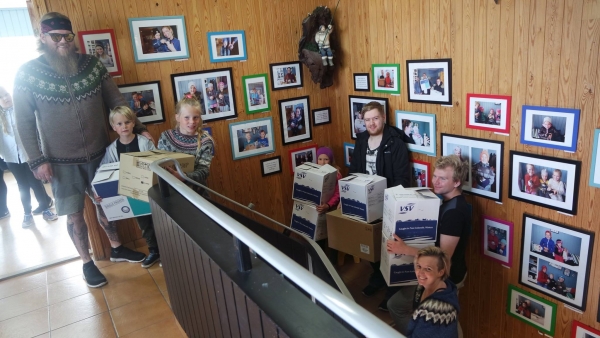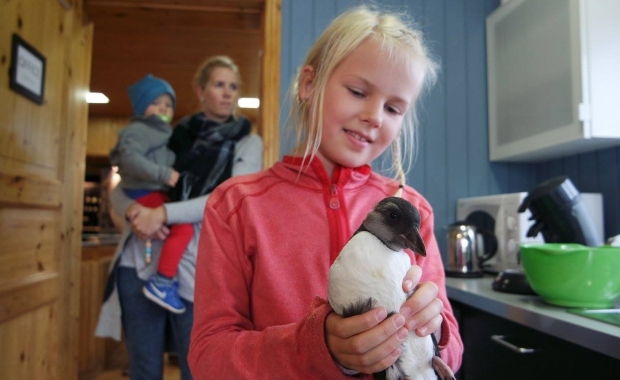The puffin isn't the national bird of Iceland, that honor goes to the gyrfalcon. But the puffins come in close second, as a kind of unofficial national bird. And they are certainly the unofficial national bird of Vestmannaeyjar islands, a cluster of volcanic islands off the south coast of Iceland.
Vestmannaeyjar are home to nearly half of the Icelandic puffin population, which makes the islands one of the most important puffin habitats in the entire world, as nearly 60% of all the world's puffins live in Iceland. The survival of the puffin population in Vestmannaeyjar is therefore of enormous importance. This is where the pysja patrols, organized by the children of Vestmannaeyjar come in!
The life and adventure of adolescent puffins

The puffins, who are a pelagic bird, spend the first 3 years of their life out on the open ocean. But by the time the birds are reaching their sexual maturity they fly back to their birthplace to build a nest and mate. Puffins choose areas to the top of sea cliffs, where there is enough earth among the rocks to permit them to dig deep burrows where their young can be safe from predatory sea birds who would otherwise attack their nests.
The puffin burrows which are built by the male puffins who use their bills to cut up the soil, shoveling it out with their feet, like dogs. The burrows extend roughly 1 meter (3 ft) into the ground. At the end of the burrow the puffins then build a nest of feathers and grass where they lay one egg. The eggs hatch, roughly six weeks later.
The survival of the puffin chicks rests on a number of factors, not least the conditions in the ocean. The time of the puffins' return to land, and their nesting, depends on the weather and distribution of their food, primarily small fish like sand eels. By fall, usually mid August to early September the young puffin chicks are strong enough to take their first leap out into the world and fly out to sea, where they will spend the next three years. Some of the chicks take a longer time to leave their burrows, the last young puffins flying off in mid October.
The Icelandic word for these young adolescent puffins, pufflings, is pysja, or less commonly kofa.
Leaping off a cliff, into the unknown

Unfortunately the little pysja are still unfamiliar with the larger world, having spent their young lives deep in a dark burrow. The little birds also have yet to fully master the art of flight. Imagine standing at the top of a cliff, looking out onto a new unfamiliar world, the cold North Atlantic, waves crashing on the rocks below, and taking a leap out into the unknown!
We don't know exactly how puffins navigate, but we know they do use visual cues, including the moon and stars. Unfortunately, if the young puffin is making his first trip to the ocean in the dark, during late evening or early morning, the lights from coastal towns can confuse the birds who mistake them for the moon and stars reflecting off the sea.
Instead of flying out to sea, these pysjas then fly into town.
Enter the pysja patrols

The town of Vestmannaeyjar in the Vestmannaeyjar islands frequently sees large flocks of pysja fly over town in September as the birds are leaving their burrows and heading to sea. While most of these birds realize their mistake and fly back to sea, some are either too tired or confused, and instead of flying back out to sea they land in town.
The people of coastal towns close to puffin colonies are therefore used to meet confused little puffins wandering the streets, unsure of how to find their way back to the sea.
Frightened by unfamiliar sights and sounds the birds hide under cars, in people's gardens in flowerbeds or under trees, or in other places which remind the pysjas of their childhood burrows. Unfortunately these wayward birds can then die of exhaustion or hunger. Others are killed by cats or hit by cars.
This is where the pysja patrols come in.
The pysja season

No town in Iceland sees more wayward pysjas than the town of Vestmannaeyjar, a small fishing town with a population of 4,200 inhabitants. The townspeople have historically had a close relationship to the birds, hunting them for food. The puffin hunt takes place in the fall, when nesting is complete and the young birds are starting to fly off to the sea. The chicks, weighing less than 300 grams (10 oz), are too small to be hunted. Except by the kids!
The children of Vestmannaeyjar organize pysja patrols in the fall, rescuing wayward pysjas in town. The pysja patrols collect pufflings in the town each night and evening. The pysjas are put into cardboard boxes where they are kept overnight, and next morning the kids take them to the cliffs by the sea where they are thrown into the wind to maximize their chances of finding their way out to sea.
The children of Vestmannaeyjar take great pride in this operation. Birds who are too weak to return immediately to the sea are fed and nursed until they seem strong enough to make it on their own in the big world.
Thousands of birds rescued each year

Beginning in 2003 the Sæheimar Natural History Museum and aquarium has been using the annual pysja rescue to monitor the condition of the local puffin colony: Every puffling rescued by the pysja patrols is taken to Sæheimar, where the little birds get a full check-up before they are released back into the wild. Some of the birds are tagged, those who have gotten oil into their feathers are cleaned and weak birds are fed and nursed back to full health.
This is no small feat as the pysja patrols bring in thousands of birds every year! The pysja season only lasts less than two months, which means Sæheimar gets on average almost a hundred birds each day. This year the children of Vestmannaeyjar brought in a record number of pysja: 4.814 pufflings were rescued by the children, more than at any time since 2003. Without the puffin patrols these puffins would most likely have perished.
Instead, there are now nearly 5,000 more puffins making their first trip out to sea, increasing the survival chances of one of the most loved sea bird species. Judging by the photos taken of the young puffin rescuers the rescue is a source of joy and pleasure to both the children and the little pufflings!
So, next time you see a puffin, you might be looking at one of the thousands of puffins which were rescued by the children of Vestmannaeyjar! Check the slideshow above for some pictures of the unsung heroes of the annual puffin rescue.
The ultimate puffin-bucket list item
If you would like to experience the annual puffin rescue, or pitch in and do your bit to help rescue the Atlantic puffin, you should visit Vestmannaeyjar during the pysja season from mid August to early October, or contact Sæheimar and offer to make a donation! [email protected]
Being able to cross see a puffin off your bucket list is one thing, actually doing your part to ensure they survive and participating in the unique puffin rescue is taking things to the next stage!

The puffin isn't the national bird of Iceland, that honor goes to the gyrfalcon. But the puffins come in close second, as a kind of unofficial national bird. And they are certainly the unofficial national bird of Vestmannaeyjar islands, a cluster of volcanic islands off the south coast of Iceland.
Vestmannaeyjar are home to nearly half of the Icelandic puffin population, which makes the islands one of the most important puffin habitats in the entire world, as nearly 60% of all the world's puffins live in Iceland. The survival of the puffin population in Vestmannaeyjar is therefore of enormous importance. This is where the pysja patrols, organized by the children of Vestmannaeyjar come in!
The life and adventure of adolescent puffins
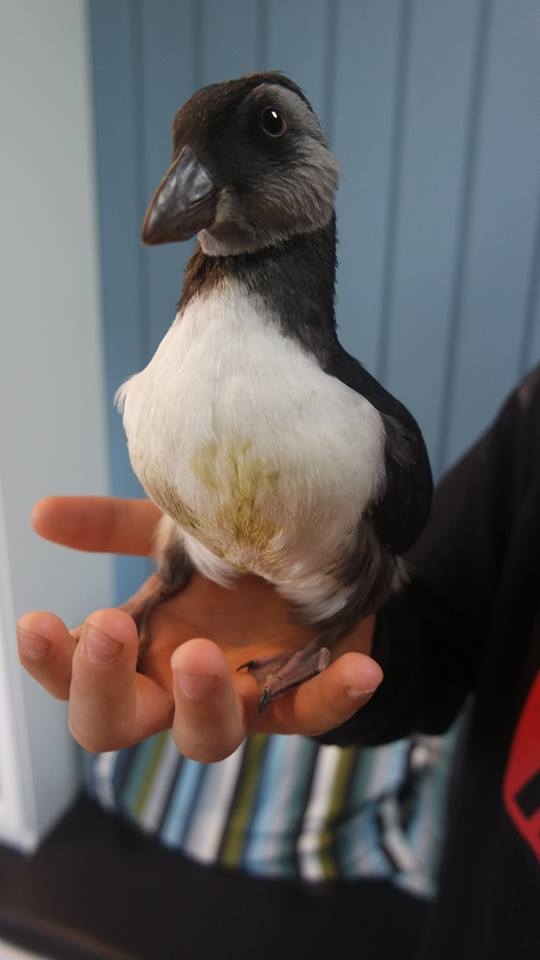
The puffins, who are a pelagic bird, spend the first 3 years of their life out on the open ocean. But by the time the birds are reaching their sexual maturity they fly back to their birthplace to build a nest and mate. Puffins choose areas to the top of sea cliffs, where there is enough earth among the rocks to permit them to dig deep burrows where their young can be safe from predatory sea birds who would otherwise attack their nests.
The puffin burrows which are built by the male puffins who use their bills to cut up the soil, shoveling it out with their feet, like dogs. The burrows extend roughly 1 meter (3 ft) into the ground. At the end of the burrow the puffins then build a nest of feathers and grass where they lay one egg. The eggs hatch, roughly six weeks later.
The survival of the puffin chicks rests on a number of factors, not least the conditions in the ocean. The time of the puffins' return to land, and their nesting, depends on the weather and distribution of their food, primarily small fish like sand eels. By fall, usually mid August to early September the young puffin chicks are strong enough to take their first leap out into the world and fly out to sea, where they will spend the next three years. Some of the chicks take a longer time to leave their burrows, the last young puffins flying off in mid October.
The Icelandic word for these young adolescent puffins, pufflings, is pysja, or less commonly kofa.
Leaping off a cliff, into the unknown

Unfortunately the little pysja are still unfamiliar with the larger world, having spent their young lives deep in a dark burrow. The little birds also have yet to fully master the art of flight. Imagine standing at the top of a cliff, looking out onto a new unfamiliar world, the cold North Atlantic, waves crashing on the rocks below, and taking a leap out into the unknown!
We don't know exactly how puffins navigate, but we know they do use visual cues, including the moon and stars. Unfortunately, if the young puffin is making his first trip to the ocean in the dark, during late evening or early morning, the lights from coastal towns can confuse the birds who mistake them for the moon and stars reflecting off the sea.
Instead of flying out to sea, these pysjas then fly into town.
Enter the pysja patrols

The town of Vestmannaeyjar in the Vestmannaeyjar islands frequently sees large flocks of pysja fly over town in September as the birds are leaving their burrows and heading to sea. While most of these birds realize their mistake and fly back to sea, some are either too tired or confused, and instead of flying back out to sea they land in town.
The people of coastal towns close to puffin colonies are therefore used to meet confused little puffins wandering the streets, unsure of how to find their way back to the sea.
Frightened by unfamiliar sights and sounds the birds hide under cars, in people's gardens in flowerbeds or under trees, or in other places which remind the pysjas of their childhood burrows. Unfortunately these wayward birds can then die of exhaustion or hunger. Others are killed by cats or hit by cars.
This is where the pysja patrols come in.
The pysja season
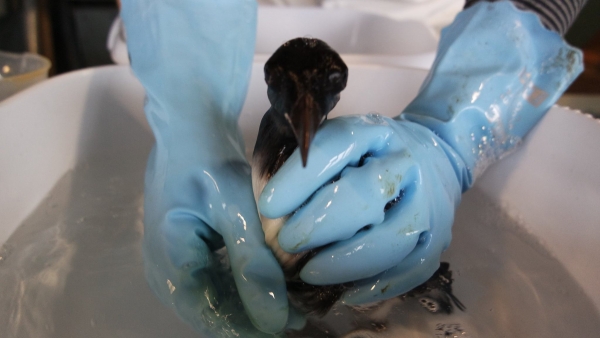
No town in Iceland sees more wayward pysjas than the town of Vestmannaeyjar, a small fishing town with a population of 4,200 inhabitants. The townspeople have historically had a close relationship to the birds, hunting them for food. The puffin hunt takes place in the fall, when nesting is complete and the young birds are starting to fly off to the sea. The chicks, weighing less than 300 grams (10 oz), are too small to be hunted. Except by the kids!
The children of Vestmannaeyjar organize pysja patrols in the fall, rescuing wayward pysjas in town. The pysja patrols collect pufflings in the town each night and evening. The pysjas are put into cardboard boxes where they are kept overnight, and next morning the kids take them to the cliffs by the sea where they are thrown into the wind to maximize their chances of finding their way out to sea.
The children of Vestmannaeyjar take great pride in this operation. Birds who are too weak to return immediately to the sea are fed and nursed until they seem strong enough to make it on their own in the big world.
Thousands of birds rescued each year
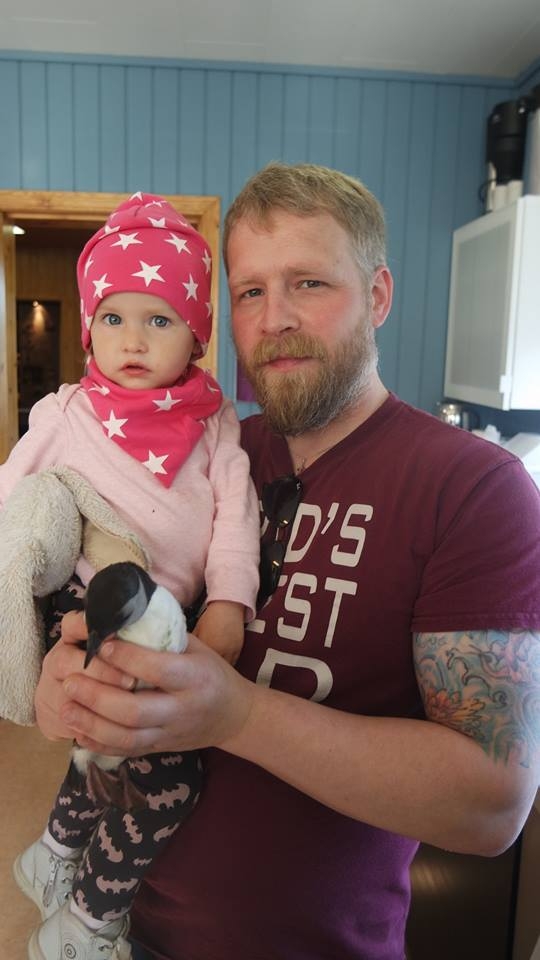
Beginning in 2003 the Sæheimar Natural History Museum and aquarium has been using the annual pysja rescue to monitor the condition of the local puffin colony: Every puffling rescued by the pysja patrols is taken to Sæheimar, where the little birds get a full check-up before they are released back into the wild. Some of the birds are tagged, those who have gotten oil into their feathers are cleaned and weak birds are fed and nursed back to full health.
This is no small feat as the pysja patrols bring in thousands of birds every year! The pysja season only lasts less than two months, which means Sæheimar gets on average almost a hundred birds each day. This year the children of Vestmannaeyjar brought in a record number of pysja: 4.814 pufflings were rescued by the children, more than at any time since 2003. Without the puffin patrols these puffins would most likely have perished.
Instead, there are now nearly 5,000 more puffins making their first trip out to sea, increasing the survival chances of one of the most loved sea bird species. Judging by the photos taken of the young puffin rescuers the rescue is a source of joy and pleasure to both the children and the little pufflings!
So, next time you see a puffin, you might be looking at one of the thousands of puffins which were rescued by the children of Vestmannaeyjar! Check the slideshow above for some pictures of the unsung heroes of the annual puffin rescue.
The ultimate puffin-bucket list item
If you would like to experience the annual puffin rescue, or pitch in and do your bit to help rescue the Atlantic puffin, you should visit Vestmannaeyjar during the pysja season from mid August to early October, or contact Sæheimar and offer to make a donation! [email protected]
Being able to cross see a puffin off your bucket list is one thing, actually doing your part to ensure they survive and participating in the unique puffin rescue is taking things to the next stage!
